Dark Mofo 2023 review: shock and awe in Florentina Holzinger’s A Divine Comedy
‘Wild’ was an undersell for the headline show at the Hobart festival – an absorbing and surprisingly joyful work featuring an all-female, all-nude cast of performers. | REVIEW

In the printed program for the ninth edition of Dark Mofo, Hobart’s winter arts festival, Leigh Carmichael gave a sketch outline of his final spin of the wheel as creative director. “There will be art, feasting, a masquerade ball, motorbikes, raving, a giant teddy and ample nudity,” he wrote. “Come down, have a drink, it’ll be wild.”
Overleaf in the program, Museum of Old and New Art creator David Walsh reflected on how, more than a decade ago, Carmichael proposed activating an event in the Tasmanian capital each June.
“I thought it unlikely to work (and I’m not the first in my family to think so – Dad said, ‘He backs the Hobart winter against any tourism business’),” wrote Walsh. “So nearly ten Dark Mofos later Leigh has thoroughly proved me wrong, and he deserves a break.”
Having exploded like a firework across the Australian festival scene in 2013, then swiftly built a reputation for hosting one hell of a party in the island state – while regularly outraging one or more community groups via controversial programming choices – Carmichael and co queued up one last bacchanalian smorgasbord to delight the senses.
Across the three nights of its final weekend, all of what the outgoing creative director promised was there in spades, bar the masquerade ball, which had opened the event on June 7.
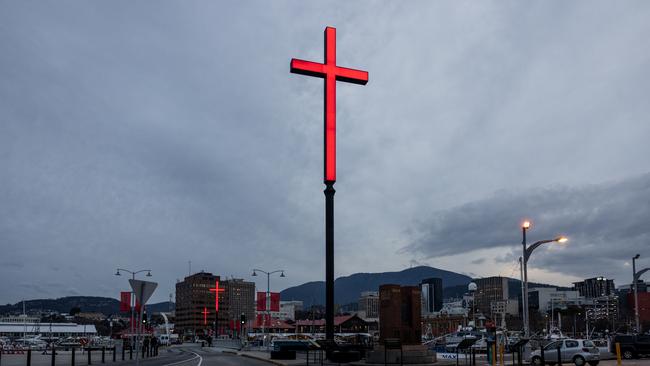
“Wild” was decidedly an undersell for one of the headline shows, titled A Divine Comedy, by Austrian choreographer, director and performance artist Florentina Holzinger. This was a shocking, absorbing and surprisingly joyful work that could be booked and showed only at Dark Mofo.
Why? Well, listing its constituent parts does it a disservice, but the two-hour show involved the following: masturbation to squirting ejaculation; blood donation; motocross; woodchopping; remote-controlled portaloos; chainsawing; and a deathbed orgasm. Strange bedfellows at any other arts festival, yet oddly par for the course for Dark Mofo.
It also included skinning and stitching back together a dead rat, all broadcast on big screens; hurdle races, complete with the firing of a starter’s gun; aerial acrobatics; two Hyundai hatchbacks and a piano hung from the ceiling; live music performed on piano, violin and cello; and synchronised defecation.
Yes, you read that right: at a key moment, six or so women took their cue to simultaneously squat and shit out an astonishingly consistent brown paste on to painters’ palettes situated at the front of the stage, mere metres from those sitting in the first row, including Walsh. (This act, too, was shown on the big screens.) If that’s not commitment to one’s artistic practice, I don’t know what is.
Held at the city’s largest indoor venue, the MyState Bank Arena on the River Derwent, A Divine Comedy was performed by an all-female cast of 20 performers of all shapes and sizes. Each of them was nude at all times, but for sensible footwear and trousers for the chainsaw operator. The naked motorcyclist wore gloves, boots and helmet, too, when expertly tearing around the stage amid her colleagues. Safety first.

The aforementioned laundry list may prompt the tiresome query of what constitutes art, but in the room its singular power was undeniable.
On Sunday afternoon, Holzinger’s work provoked a scattering of walkouts from ticketholders, most noticeably when the appearance of a hypodermic needle made it apparent that one of the performers would be donating her blood to a group artwork splashed on a white canvas at the back of stage. (A hundred or so walked out of its first showing on Friday night, I heard.)
In sum, it offered a fascinating span of human actions and behaviours, all framed around the loose story of an elderly, wheelchair-bound dancer – played by 82-year-old Beatrice “Trixie” Cordua – near the end of her life, imagining her funeral preparations, which she occasionally narrated.

At times it felt as though the work was mirroring aspects of life itself, including the repetitions of daily motions that comprise our time on earth as we walk towards our inevitable deaths. To watch these women work together in synchrony, in an environment of controlled risk, was a beautiful spectacle that showed the good, bad and ugly of what our bodies can do.
There were sections that irritated and inspired flickers of tedium, but the overall effect was among the most impressive, transgressive and affecting shows I’ve seen, thanks to a truly remarkable feat of artistic endurance from all involved.
In the music program, highlights included King Woman, led by Kristina Esfandiari, whose stunning vocal tone sat somewhere between Courtney Love, Patti Smith and PJ Harvey, while her bandmates’ storming alt-rock arrangements brought to mind fellow US act Queens of the Stone Age. Largely unknown here, King Woman’s Saturday night set owned the room before about 500 people at the Odeon Theatre and concluded with a slowed-down, sludged-up cover of the Stone Roses’ I Wanna Be Adored.

Another American group named Health dominated the same space on Sunday with its scorching blend of noise and melody. A power trio featuring the tom-heavy drum style of BJ Miller, the Californians have spent 15 or so years mining a rich sonic vein wherein mankind and machine work together to bend electronic and industrial rock tones as one.
It had been seven years between Australian visits, and the three musicians were in a mood to make up for lost time, tearing through more than 20 songs in an hour on stage while flanked by a battery of strobe lighting.
Sunday’s final performance was by alternative electronic act Trentemoller, at the waterfront hangar known as MAC2, in a concert that was every bit as intense and inspiring as Health but before a much bigger crowd of about 2000.
Its previous visit to our shores was in 2011, and in an Australian exclusive the group – led by Danish composer and producer Anders Trentemoller – brought a massive sound to Hobart that skirted ethereal post-rock, dream pop and shoegaze, occasionally featuring the vocals of Disa Jakobs, whose wonderfully clear voice cut through the band’s icy wall of sound.
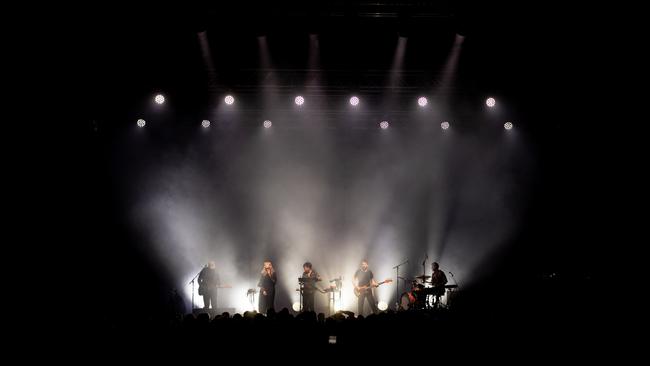
After 10pm on Friday and Saturday, the streets, laneways and venues surrounding the Odeon were given over to the rolling maul known as Night Mass, a giant block party wherein the ideal mindset approach was to expect the unexpected.
In dozens of spaces large and small, thousands of bodies surged through the urban bloodstream, taking in unusual sights, sounds, smells and scenes, including the Giant Teddy by Sydney-based multidisciplinary artist EJ Son, which commanded the dance floor abutting Harrington Lane.

It was at Night Mass, inside the Red Room around 1am Sunday, that performance artist and self-described “sex clown” Betty Grumble jumped on a small stage before 100 or so people.
To the soundtrack of a Prince classic, she cut off her clothes with scissors, lathered herself in soap suds, shaved her pubic hair and concluded by holding a handstand pose stark naked, legs akimbo – flowers protruding from inside her – while reciting a lengthy, moving poem. It was a freakish display of vulnerability and stamina, all conducted metres from unruffled bar staff who continued nonchalantly to mix cocktails. I’ll never hear Purple Rain the same way again.
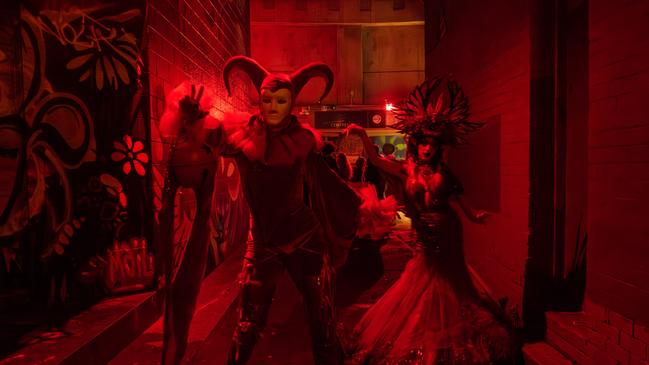
Next year, incoming artistic director Chris Twite has his hands full with moulding the next few years of this strange and uplifting undertaking into something of his own making. What Carmichael, Walsh and co have done thus far is to shake Hobartians from their usual slumber in the colder, darker months, and encourage them to step towards the light.
For the ninth event, the programmers brought back Ryoji Ikeda’s striking large-scale work known as Spectra, a towering set of dozens of powerful light beams pointed skyward, which together could be seen from kilometres away.

It was inside the gravel-lined open space of Dark Park on Sunday night, nearby that piercing beacon, that the Ogoh-Ogoh – a large, totem-like sculpture derived from a Balinese Hindu purification ritual – was set alight by a shower of sparks held aloft by a crane truck.
When was the last time I gathered with thousands of people to watch something burn? Quite possibly never before in my life. Yet there we were, crossing off an unusual life experience from our collective bucket list.
In a crowd that organisers estimated as close to 20,000, kids perched on dads’ shoulders, casting their eyes towards a smouldering effigy of a duck-billed platypus, young lives caught up in the illicit thrill of being outside on a chill winter’s eve.
Much of Dark Mofo is commercialised, and unavoidably so: the festival is a business, not a charity. Most of what was reviewed here were ticketed events, and in this respect the 2023 edition was a record-breaker: organisers counted 427,000 total entries across the festival, a 60 per cent increase on last year, including more than 100,000 tickets sold, grossing $5.5m.
But The Burning, as it’s dubbed, was for everyone – even the handful of Jesus freaks handing out pamphlets near the entrance of Dark Park, smiling serenely and singing songs of peace. As the masses streamed past them towards the towering visage of Spectra, these committed followers of Christ offered marketing materials telling us that JC loved us and that we could all still be saved before we passed beneath the glowing red signage.
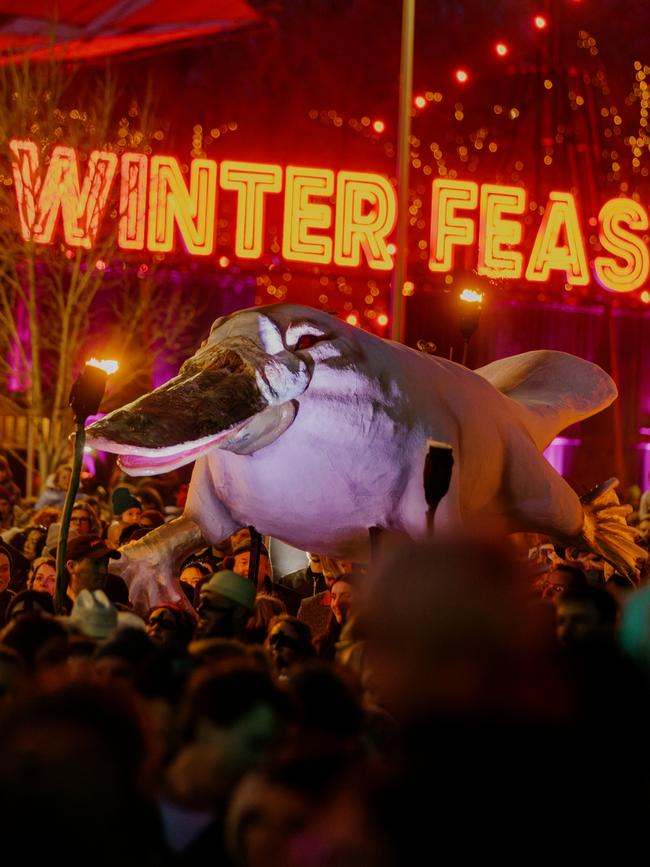

But there was no salvation for the doomed platypus, which went up in a blaze of surprising ferocity as the throng cheered its demise. Its insides were stuffed with thousands of festivalgoers’ handwritten fears, gathered across the preceding 10 days, all of which were sent skyward in flames.
As the crowd dissipated and the effigy turned to ash, renewal was already beginning apace. Another festival beckons, and another burning, so long as we keep on coming back – and we will, so long as the curators continue their run of programming daring, thought-provoking and enlivening art that makes it worth the trip.
The writer travelled to Hobart as a guest of Dark Mofo.




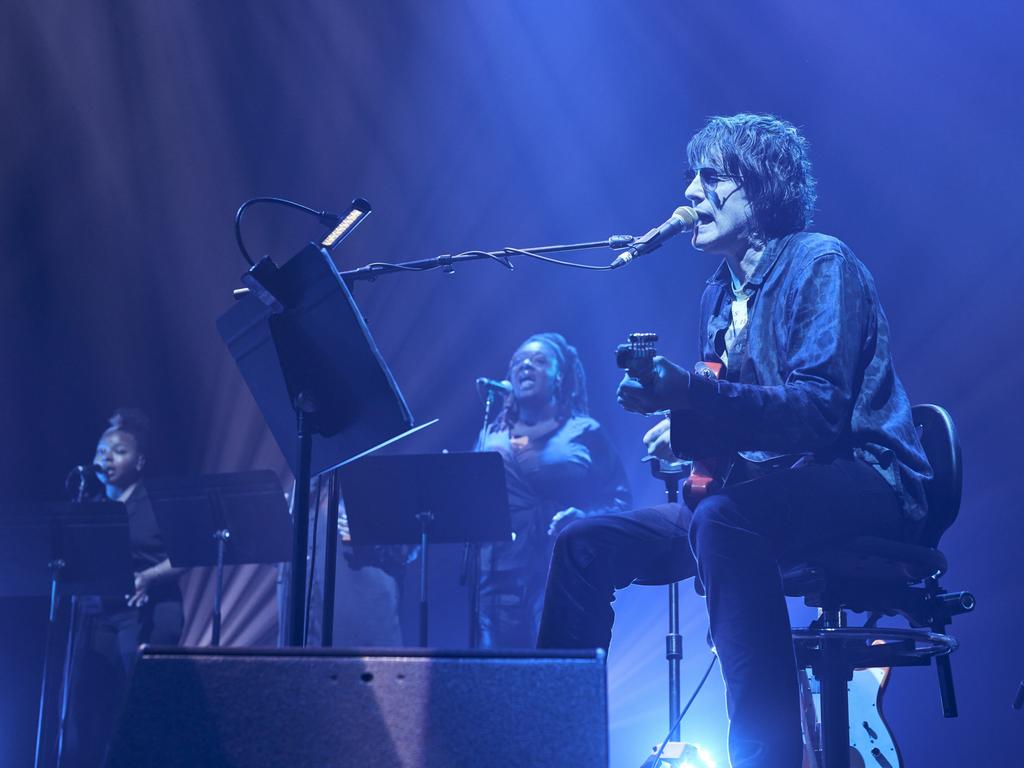

To join the conversation, please log in. Don't have an account? Register
Join the conversation, you are commenting as Logout